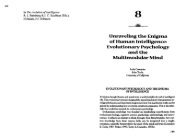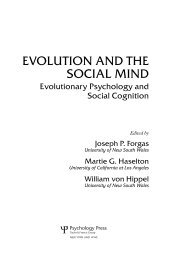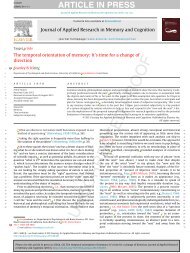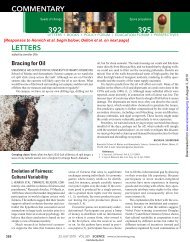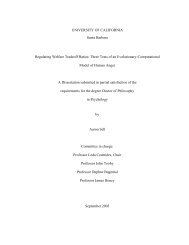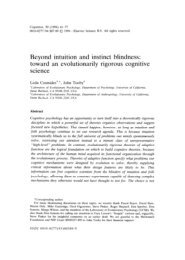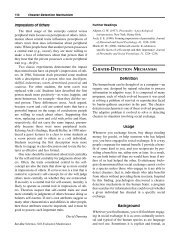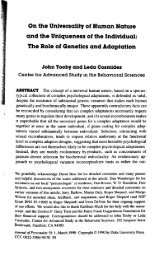Cinderella Effect: The Facts - Center for Evolutionary Psychology
Cinderella Effect: The Facts - Center for Evolutionary Psychology
Cinderella Effect: The Facts - Center for Evolutionary Psychology
You also want an ePaper? Increase the reach of your titles
YUMPU automatically turns print PDFs into web optimized ePapers that Google loves.
<strong>The</strong> <strong>Cinderella</strong> effect - 2<br />
It is on these grounds that we hypothesized, many years ago, that any and all sorts of abuse and<br />
exploitation would be seen to occur at higher rates in steprelationships than in genetic parent-child<br />
relationships, and that the differences would persist when possible confounds such as socio-economic<br />
status were controlled <strong>for</strong> (see Daly & Wilson 1998). This hypothesis has since been abundantly<br />
supported in our own research and in that of many others. This differential (mis)treatment is what we<br />
refer to as the “<strong>Cinderella</strong> effect”.<br />
Fatal batterings of small children<br />
This most severe category of child maltreatment exhibits <strong>Cinderella</strong> effects of the greatest magnitude: in<br />
several countries, stepparents beat very young children to death at per capita rates that are more than<br />
100 times higher than the corresponding rates <strong>for</strong> genetic parents.<br />
<strong>The</strong> most thorough analyses are <strong>for</strong> Canada, where data in a national archive of all homicides known to<br />
police indicate that children under 5 years of age were beaten to death by their putative genetic fathers<br />
at a rate of 2.6 deaths per million child-years at risk (residing with their fathers) in 1974-1990, while the<br />
corresponding rate <strong>for</strong> stepfathers was over 120 times greater at 321.6 deaths per million child-years at<br />
risk (Daly & Wilson 2001). Note that because few small children have stepfathers, this rate differential<br />
does not, in itself, convey anything about the absolute numbers of victims; what these rates represent are<br />
74 fatal batterings by genetic fathers in 28.3 million child-years at risk, and 55 by stepfathers in 0.17<br />
million child-years at risk.<br />
Estimates of this sort have not been made <strong>for</strong> other countries, but it is clear that this immense excess risk<br />
to stepchildren is not peculiar to Canada. In England & Wales in 1977-1990, <strong>for</strong> example, 117<br />
children under five years of age were beaten to death by putative genetic fathers and 103 by stepfathers<br />
(Daly & Wilson 1994). As in Canada, the available population-at-large survey data indicate that fewer<br />
than 1% of British children of the same age as the victims dwelt with stepfathers, while over 90% dwelt<br />
with putative genetic fathers, and so, as in Canada, the difference in per capita rates of such fatal<br />
assaults is well over 100-fold.<br />
Australian data indicate an even larger <strong>Cinderella</strong> effect. Wallace (1986) reported that perpetrators of<br />
fatal baby batterings in New South Wales in 1968-1981 included 11 putative genetic fathers and 18<br />
stepfathers, even though the victims’ median age was only 12 months. Strang (1996) reported that<br />
comparable cases <strong>for</strong> the country as a whole in 1989-1993 included 11 children killed by putative<br />
genetic fathers and 12 by stepfathers, although the victims’ median age was in this case less than 1 year.<br />
For both of these samples, the age distribution was such that fewer than 0.5% of a random sample of<br />
same-age children from the population-at-large would be expected to have had a stepfather according<br />
to Australian Family Characteristics Survey data, and the estimated relative risk from stepfathers vs<br />
genetic fathers exceeds 300-fold.<br />
<strong>The</strong>re are no high-quality national data on fatal batterings in the United States, but the available evidence<br />
again indicates a large overrepresentation of stepchildren as victims. According to an analysis of the<br />
FBI’s Supplemetary Homicide Reports (SHR) case data by Weekes-Shackel<strong>for</strong>d & Shackel<strong>for</strong>d<br />
(2004), stepfathers beat children under 5 years old to death at a rate of 55.9 per million children at risk



